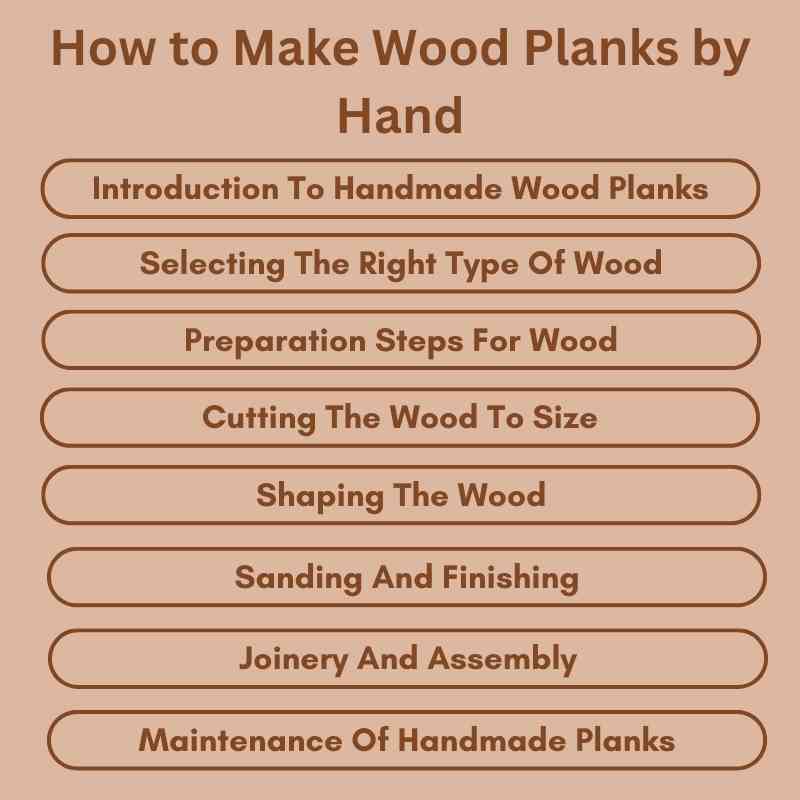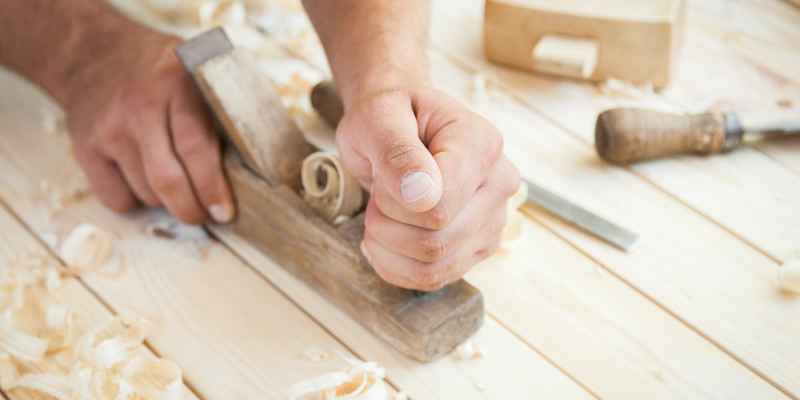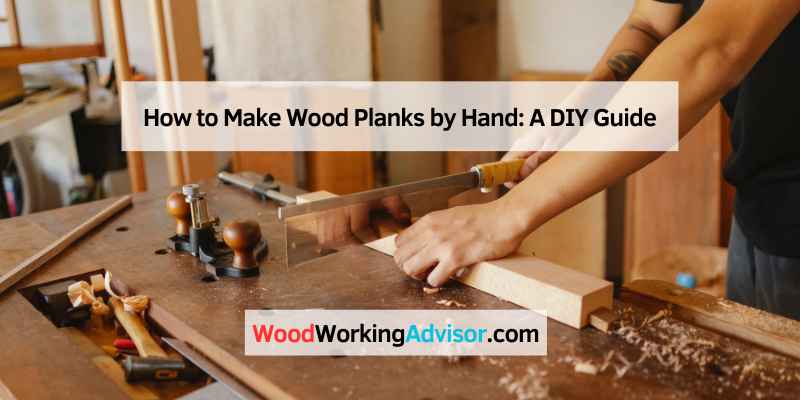To make wood planks by hand, start by selecting a suitable log and cutting it into manageable sections. Use a hand saw or chainsaw to slice the sections into planks of desired thickness.
Creating wood planks by hand is a rewarding skill that connects you with traditional craftsmanship. Many woodworkers prefer this method for its authenticity and the control it provides over the material. Hand-cutting wood planks allows you to tailor each piece to your project’s specific needs, whether for furniture or flooring.
Understanding the tools and techniques involved can enhance your woodworking experience. This process not only preserves the natural beauty of the wood but also fosters a deeper appreciation for sustainable practices. Embrace the journey of transforming raw logs into functional art.
Introduction To Handmade Wood Planks
Making handmade wood planks is a fun and rewarding project. It allows for personal creativity and customization. DIY woodworking offers many benefits that go beyond just saving money.
First, it enhances your skills and boosts your confidence. Second, it provides a sense of accomplishment. You can create unique pieces that suit your home perfectly.
Tools needed for the job include a saw, a plane, and a sander. A measuring tape ensures accurate cuts. Don’t forget safety gear like gloves and goggles.
| Tool | Purpose |
|---|---|
| Saw | Cutting wood to size |
| Plane | Smoothing the surface |
| Sander | Finishing the edges |
| Measuring Tape | Ensuring accuracy |
| Safety Gear | Protecting yourself |

Selecting The Right Type Of Wood
Choosing the right type of wood is very important. Different wood species have unique characteristics. Here are a few common types:
| Wood Species | Characteristics |
|---|---|
| Oak | Strong and durable, great for furniture. |
| Maple | Hard and dense, often used for flooring. |
| Pine | Lightweight and easy to work with, good for beginners. |
Sourcing sustainable timber helps the environment. Look for wood from managed forests. This ensures that new trees are planted. Always check for certifications like FSC or PEFC. These certifications guarantee responsible forestry practices.
Preparation Steps For Wood
Start by gathering your tools. A tape measure and pencil are essential. Measure the wood carefully. Mark the measurements clearly on the wood. This helps avoid mistakes later.
Always wear safety goggles to protect your eyes. Use ear protection if using loud tools. Keep your work area clean and organized. This helps prevent accidents.
Make sure to use gloves if handling rough wood. Check for any splinters or sharp edges. Staying safe is very important when working with wood.
Cutting The Wood To Size
Using a saw is crucial for making straight cuts. A hand saw works well for smaller projects. For larger pieces, consider using a circular saw. Always measure twice to ensure accuracy.
To achieve consistent thickness, follow these tips:
- Use a straight edge as a guide for cutting.
- Keep the saw blade sharp for clean cuts.
- Take your time and apply even pressure while sawing.
- Check the thickness frequently with a caliper or ruler.
Practice makes perfect. With careful cuts, your wood planks will look great.
Shaping The Wood
Planing techniques help create smooth surfaces on wood planks. Start with a hand plane. Hold it at a slight angle. Apply even pressure while moving it along the wood grain.
Check the surface often for smoothness. Repeat planing until the desired finish is achieved. Always use a sharp blade for best results.
Chiseling edges and corners adds precision to your wood planks. Choose a sharp chisel for clean cuts. Hold the chisel firmly and tap it gently with a hammer.
Work slowly to avoid damaging the wood. Make small, controlled cuts to shape the edges. This method helps achieve a professional look.
Sanding And Finishing
Choosing the right grit is essential for sanding wood planks. Start with a coarse grit, like 60 or 80, to remove rough spots. Then, gradually move to a finer grit, such as 120 or 220, for a smooth finish. Always sand in the direction of the wood grain to avoid scratches.
Applying finishes helps protect the wood. Options include oil, varnish, or polyurethane. Each finish provides different durability and appearance. Use a clean brush or cloth to apply the finish evenly. Allow adequate drying time between coats. This process enhances the wood’s natural beauty and increases its lifespan.
Joinery And Assembly
Using basic wood joints is key for strong plank attachment. Common joints include the butt joint, lap joint, and biscuit joint. Each joint has its own benefits and uses. Choose the right joint based on your project needs.
Gluing and clamping are vital for ensuring strength. Apply a good quality wood glue to the joint area. Use clamps to hold the pieces tightly together. Make sure the clamps are evenly spaced for best results. Allow the glue to dry completely before removing the clamps.
| Wood Joint Type | Description |
|---|---|
| Butt Joint | Simple and easy to make, but not very strong. |
| Lap Joint | Provides more surface area for glue, making it stronger. |
| Biscuit Joint | Uses small wooden biscuits to align and strengthen joints. |
Maintenance Of Handmade Planks
Cleaning handmade wood planks is essential for their longevity. Use a soft cloth for dust. For deeper cleaning, mix mild soap with warm water. Avoid harsh chemicals that can damage the wood.
Regularly check for signs of wear. Look for scratches or dull spots on the surface. If these appear, it might be time to refinish or repair the planks.
Refinishing can restore the wood’s natural beauty. Sand the surface lightly before applying a new finish. Repair any cracks with wood filler for a seamless look.
| Task | Frequency |
|---|---|
| Dusting | Weekly |
| Deep Cleaning | Monthly |
| Refinishing | Every 1-3 years |
| Repair | As needed |
Creative Projects Using Handmade Planks
Handmade wood planks are great for many creative projects. Furniture making is a fun way to use them. Build a simple table or a cozy bench. Unique chairs can also be crafted from these planks.
Decorative applications add charm to any space. Use planks to create beautiful wall art. Shelves made from wood planks look stylish and are very practical. Picture frames from handmade wood can showcase your favorite memories.
- Wooden coffee tables
- Rustic dining tables
- Garden benches
- Wall-mounted shelves
- Handcrafted picture frames

Frequently Asked Questions
How Do I Start Making Wood Planks By Hand?
To start making wood planks by hand, gather your materials. You’ll need a suitable log, a saw, and hand tools like a chisel and mallet. Begin by cutting the log into manageable sections. Then, use the saw to slice it into planks of your desired thickness.
What Tools Do I Need For Hand-making Wood Planks?
Essential tools for hand-making wood planks include a handsaw, chisel, mallet, and a measuring tape. A square helps ensure straight cuts, while a drawknife can refine the edges. These tools will help you achieve precision and quality in your woodworking project.
Can I Make Wood Planks From Any Type Of Wood?
Yes, you can make wood planks from various types of wood. However, choose hardwoods like oak or maple for durability. Softwoods like pine are easier to work with but may not last as long. Always select wood that suits your project’s needs and aesthetic.
How Long Does It Take To Make Wood Planks By Hand?
The time it takes to make wood planks by hand varies. It depends on factors like the type of wood and your experience level. Generally, it can take several hours to a few days. Planning your project and working efficiently can help reduce the time needed.
Conclusion
Creating wood planks by hand is a rewarding skill. It connects you with traditional craftsmanship while offering personal satisfaction. By following the right techniques, you can produce high-quality planks for your projects. Embrace the process, experiment with different woods, and let your creativity shine.
Your handcrafted planks will be truly unique.

